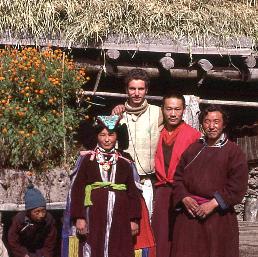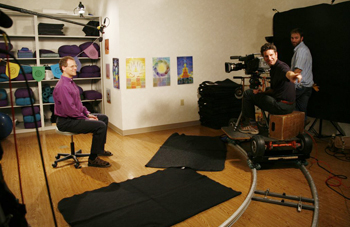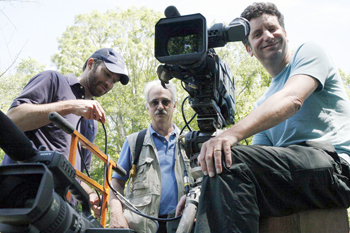
Steven Schecter began making documentaries in junior high school, growing up in Washington, DC. He attended an Ethnographic Film Conference at the Smithsonian Institution as a high school panelist, while apprenticing at Guggenheim Productions, the premier documentary shop in DC. At the Smithsonian he met E. Richard Sorenson, who was starting an Ethnographic Film Center with Margaret Mead’s backing. The summer after Steve’s freshman year at Harvard (1975), Sorenson sent Steve to Brazil to film the Canela Indians. Thus began seven years of Steve’s work for the Smithsonian’s National Human Studies Film Center.
He alternated work for the Smithsonian with his studies in social anthropology at Harvard under Professor Stanley Tambiah. Steve filmed coral atoll-dwellers on Puluwat in Truk State in Micronesia, and then lived for a year filming on Woleai and Ifaliuk Atolls in Yap State. On Puluwat he lived in the canoe house of the senior navigator, Hipour, reknowned for his skills throughout the Pacific. Steve was a passable Woleaian speaker at the end of his stay.

Steve lived in the Mathoo Monastery in Ladakh on two trips of several months. This area in the Himalayas of Northwest India, is one of the few remaining places where Tibetan Buddhism is practiced in its traditional environment. Steve filmed ritual life in the monastery, and daily life in the village below, looking at the interdependence between monks and laypeople. He also filmed the Newari farmers in the Kathmandu Valley of Nepal. The 150 hours of film Steve shot in Brazil, Micronesia, India, and Nepal is preserved in controlled environment vaults at the Smithsonian. Steve completed his BA in social anthropology in 1980 at Harvard, magna cum laude, with a film and paper about the Oracles of Mathoo in Ladakh.
Schecter started his own company as an independent producer in 1983. His first documentary broadcast on PBS that same year is called The Inner Runner, about a 24 hour running race.
In 1987 Steve was director of photography on Our Parents, Our Children, Ourselves, a Glen Pearcy Production on the long term care debate completed for Families USA. That program was a finalist in the Film & Television Festival of New York. In 1994, Schecter again collaborated with Pearcy as director of photography and editor on People Just Like You, a program on the tragedies of those without health insurance, again for Families USA. This program won an award at the Intercom Festival that year.

A fluent Russian speaker after attending Soviet school as a child, Schecter worked annually in the Soviet Union and then Russia from the mid-eighties to the mid-nineties. In 1988, Steve was director, cameraman, editor and writer of My Russian Friends, a one hour special on the search for spiritual roots by ordinary Russians, a co-production with WGBH Boston. It was awarded the Silver Hugo at the 1988 Chicago International Film Festival. In 1990 he produced The Party Is Over on the impending death of the Communist Party in the USSR, broadcast nationally on the PBS show The Nineties.
In 1993, Steve worked as co-producer on developing 10 Days in August, a dramatic mini-series on recent Russian history for Hearst Entertainment Productions, interviewing Gorbachev, Yeltsin, and others involved in the Coup that led to the fall of the Soviet Union. Later that year and in 1994, he served as the director of photography on Dai Sil Kim-Gibson's award-winning documentary, A Forgotten People, about the Koreans abandoned on the island of Sakhalin. In 1995 Schecter was field producer, additional camera, and translator on MIR-18: Destination Space, National Geographic EXPLORER's documentary about the first American astronaut to blast off from earth on a Russian rocket.
In 1992 Steve continued his long-time association with Greer, Margolis, Mitchell, Burns & Associates, producing and editing commercials for the Clinton presidential campaign. In 1995 and 1996, Steve served as principal director of photography on Lumiere Productions' critically-acclaimed six hour series on the religious right, entitled: With God On Our Side. In the fall of 1998, the Discovery Channel broadcast VANISHED: Inside the Witness Protection Program which Steve shot with director Calvin Skaggs of Lumiere Productions.
Steve's work in the nineties includes Preserving Our Global Environment, a one hour program for educational distribution completed for the World Resources Institute, hosted by Jessica Mathews and David Gergen. In 1996, Steve worked on several programs for the reformed Teamsters union, as producer and director of photography with Glen Pearcy Productions.

Schecter was director of photography on WINDHORSE, Paul Wagner's dramatic feature about the struggle against the Chinese in contemporary Tibet. Steve shot undercover in Lhasa for a week with a mini-DV camera to get the baseline exteriors, and then for another month and a half in Nepal in wide-screen digital betacam for best results on the blow-up to 35mm for theatrical release. WINDHORSE received the Best U.S. Independent Feature award at the 1998 Santa Barbara International Film Festival among other festival awards, and began its domestic theatrical release in February, 1999. It is considered by many to be the first digitally-shot feature film.
In the fall of 1997, Schecter returned to Brazil to shoot new material for use in his program: Intimate Truths of the Canela Tribe, a co-production with the Smithsonian, which was broadcast domestically by the Discovery Channel and internationally by National Geographic Channels in the fall of 1999. This documentary about sexual sharing among the Canela has since been shown thirty times on the Discovery Channel.
In 2003, Schecter completed Passion & Discipline: Don Quixote’s Lessons for Leadership. The feature documentary is an unconventional look at leadership through great works of literature, completed for the Stanford Graduate School of Business with Professor Emeritus James G. March, one of the world’s most influential thinkers on management and organizations. The program was broadcast on PBS. In 2005 Steve completed a half hour documentary: Headstrong: Inside the Hidden World of Dyslexia and ADHD, also broadcast on PBS.

In 2008, Schecter completed another hour documentary with Professor March on leadership issues in Tolstoy’s War and Peace, called Heroes and History, this time for the Yale School of Management, shot in Russia, Italy, Denmark, and the US. At Stanford University, Steve is filming work being carried out on the future of the Internet. In the Bay Area, he is producing short films on the work of the Niroga Institute. Niroga uses yoga, breathing, and mindful meditation to help at-risk youth. In 2010, Steve completed a ten-minute documentary for Positive Coaching Alliance, on using youth sports to transform youth, as the organization expands nationwide. Steve is currently completing Mindful Kids, a feature-length documentary about teaching Mindfulness in the Oakland schools. He has recently finished five two-minute videos for Peninsula Open Space Trust for their Heart of the Redwoods conservation campaign. He is also completing multiple short videos for Headstrong Nation, an international organization, dedicated to the rights of the dyslexic community.
